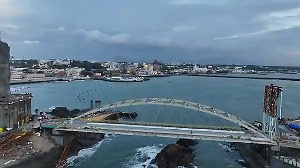Scientists have found radioactive material from the crippled Fukushima nuclear reactor in tiny sea creatures and ocean water some 600 km off the coast of Japan, revealing the extent of the release and the direction pollutants might take in a future environmental disaster.
Using 24 specially equipped drifting buoys, a team led by researchers from the Woods Hole Oceanographic Institution in Massachusetts found radioactive isotopes -- slightly different versions of elements -- derived from the plant in seawater as well as in various microorganisms and a small sample of fish.
In some places, the WHOI team discovered cesium radiation hundreds to thousands of times higher than would be expected naturally, with ocean eddies and larger currents both guiding the "radioactive debris" and concentrating it.
With these results, published in the journal Proceedings of the National Academy of Sciences, the researchers estimate that it will take at least a year or two for the radioactive material released at Fukushima Daiichi plant to get across the Pacific Ocean.
"We saw a telephone pole," study leader Ken Buesseler, a marine chemist and oceanographer at WHOI, told LiveScience.
"There were lots of chemical plants. A lot of stuff got washed into the ocean."
The Fukushima nuclear plant was destroyed by a massive tsunami that wreaked havoc across the coastal Japan following a powerful quake on March 11, 2011.
To find out how that radiation spread in the waters off Japan, the researchers in June released "drifters" small monitoring devices that move with the current and take measurements of the surrounding water.
The drifters are tracked via GPS, showing the direction of currents over a period of about five months. Meanwhile, the team also took samples of zooplankton (tiny animals) and fish, measuring the concentration of radioactive cesium in water.
Elevated concentrations of Cesium-134 at levels up to 325 becquerels per square meter were found more than 600km from the Fukushima nuclear plant, the Voice of America reported.
A circular pattern of ocean current, known as an eddy, is responsible for the highest ocean radioactive hotspot of 3,900 Bq per square meter, located 130 km off the Fukushima coast.
Buesseler said the marine radiation levels are comparable to those seen after past accidents, such as Chernobyl accident in 1986.










 © 2024 Rediff.com -
© 2024 Rediff.com -